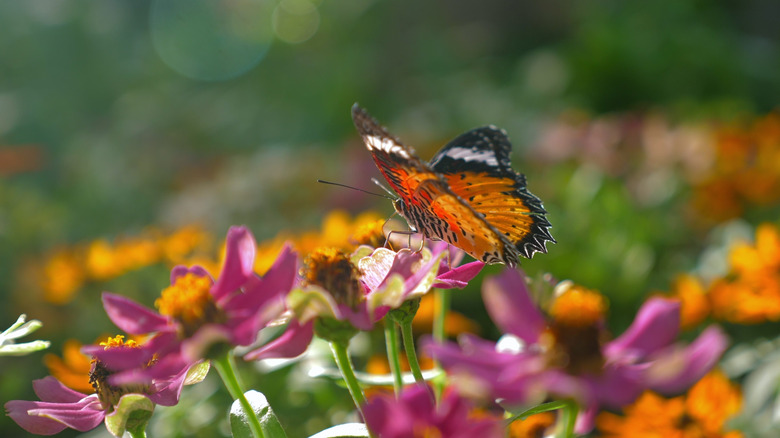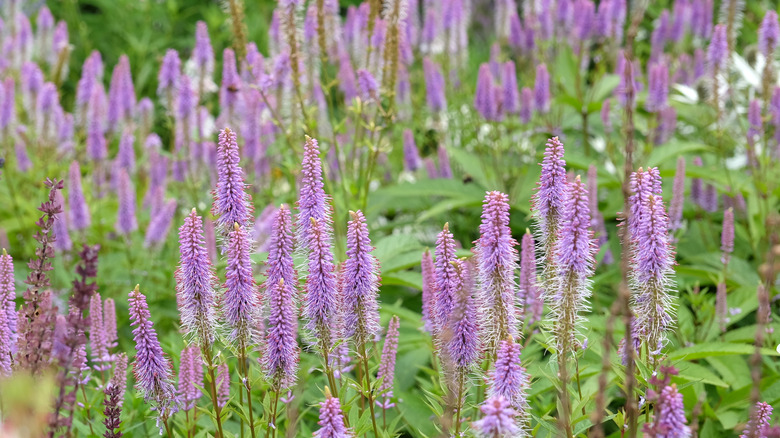The Meadowy Perennial That Will Attract Butterflies To Your Garden
Hoping to attract more butterflies to your garden? Look no further than meadowy Culver's root (Veronicastrum virginicum). Though it isn't the most well-known pick, this enduring, low-maintenance perennial boasts tall, lance-shaped leaves and spiky flowers with white, pink, or blue blooms. Culver's root is native to North America, can adapt to different temperatures and sun conditions, and grows well in Hardiness Zones 3 through 9. Best of all, this flowering plant is a magnet for a number of birds and insects, including hummingbirds, honeybees, carpenter bees, bumblebees, and — you guessed it — butterflies.
Butterflies and bees are drawn to Culver's root because of its flowers, which provide key nutrients they need to thrive. Plant it in your garden or yard, and you won't just attract critters that are pretty to look at from afar. You'll also do your part to promote native plants and support pollinating insects, which play a crucial role in your local ecosystem. It's a win-win!
How to plant and tend to Culver's root
Culver's root is easy to plant and maintain, but be warned, it can take up to two years to flower (and attract all those gorgeous butterflies). To reap the rewards right away, it's probably a good idea to purchase a nursery-grown plant versus planting it from seed. To replant Culver's root, first locate a patch of land that gets light shade or full sun. This flowering plant needs at least six hours of sunlight per day to thrive. Keep in mind that it grows upright, too. Then, add some organic mixture to your soil to improve drainage. From there, simply dig a hole and insert the plant's root ball into it, ensuring that it remains intact. It's best to space it out at least 3 feet away from other plants so it has plenty of room to grow.
Since this plant is native to woodland and prairies, Culver's root isn't particularly fussy or temperature-sensitive once established. Its flowers are also resistant to deer and rabbits. However, it grows best in soil that's medium to wet and drains well. Be sure to water your patch of Culver's root regularly — unless you're getting consistent rain, in which case, you can step back and let Mother Nature do what she does best.
Flowering plants to pair with Culver's root for a pollinator garden
If you're thinking about planting Culver's root, consider adding other flowers that also draw bees and butterflies to start a pollinator garden. For instance, purple coneflower (Echinacea purpurea) thrives in the same USDA Hardiness Zones as Culver's root, is also deer- and drought-resistant, and features dainty, long-lasting lavender flowers that will complement the latter's spiky, conical blooms. This native perennial needs full sun, though, so be sure to plant it in a patch where it will get plenty of light. You'll want to keep an eye on its growth, too. Since it's a self-seeding plant, it can sometimes grow out of control and spread to parts of your garden where it isn't wanted.
Aster (Asteraceae) is another flowering perennial that grows well in similar conditions to Culver's root and will attract butterflies. With its bright, daisy-like blooms and 600 native subspecies, it's a popular option among home gardeners. As a bonus, aster flowers in late summer and early fall, when many other plants have already lost their blossoms. Add this hardy, sun-loving plant to your yard or garden, and you'll notice eye-catching blooms even as temperatures start to drop.


